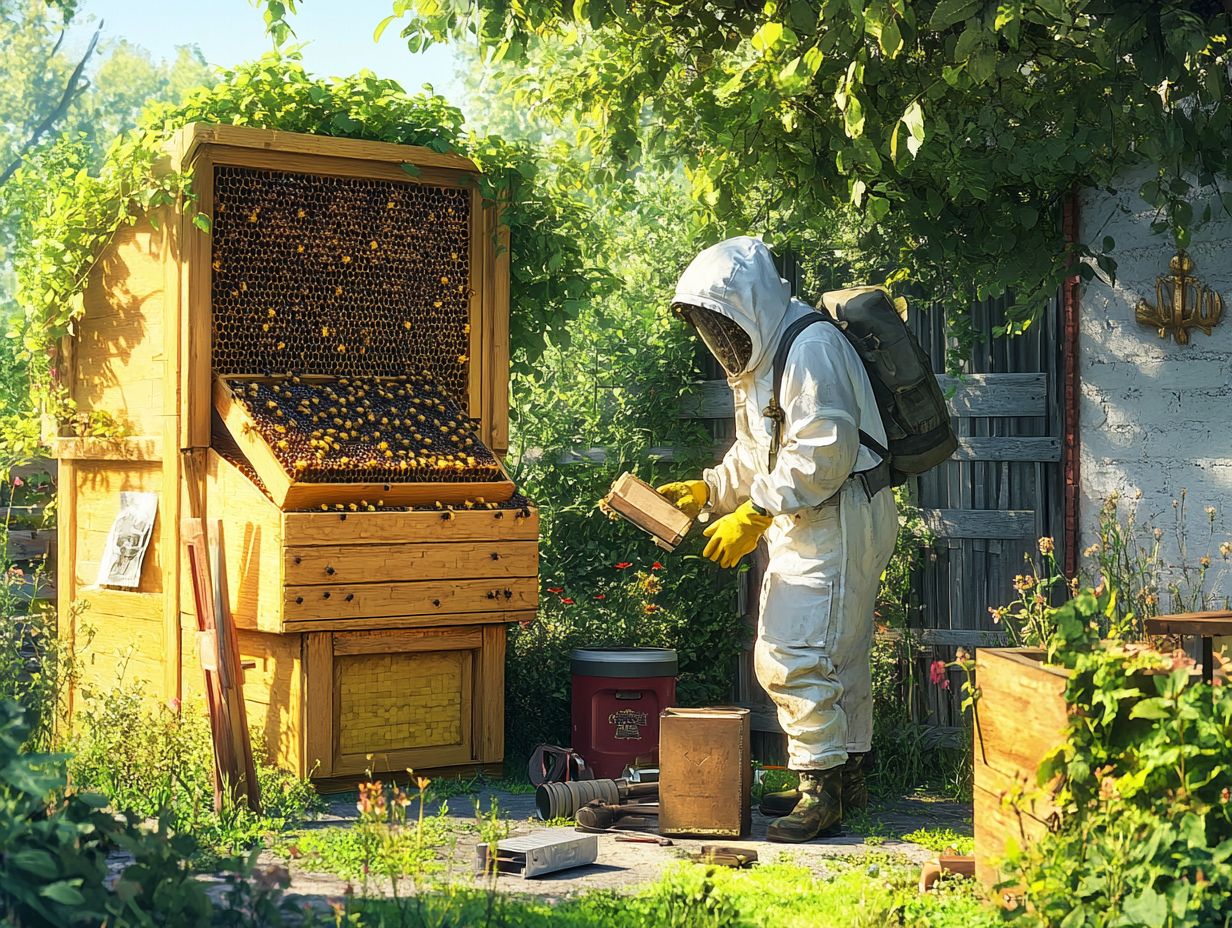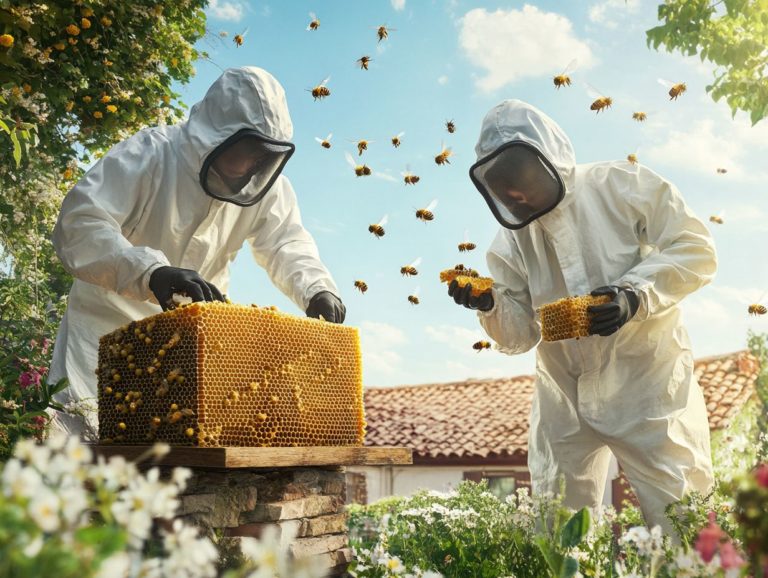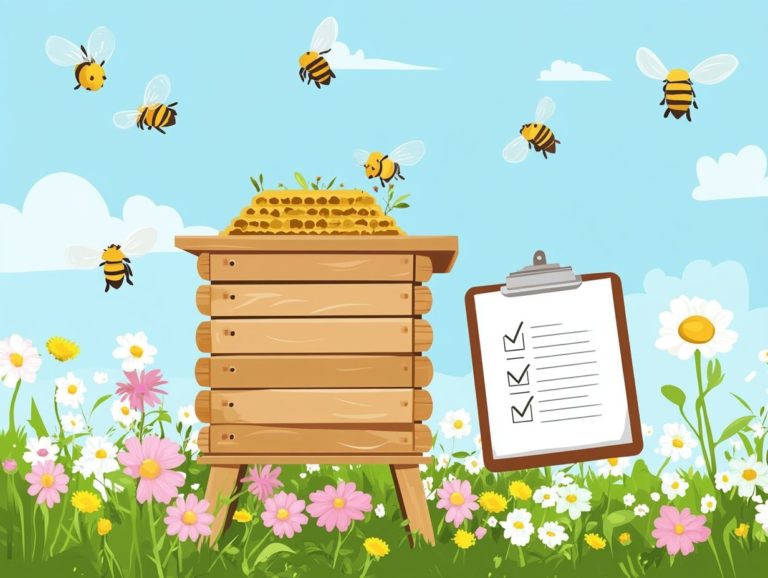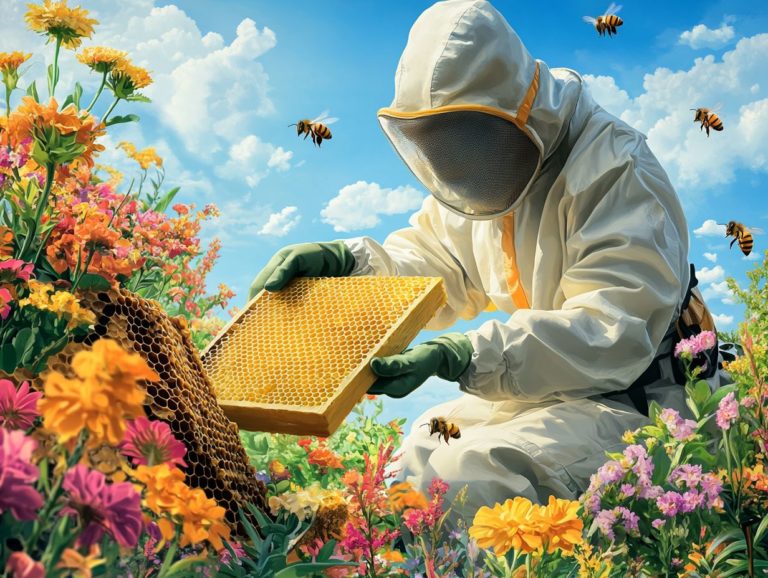How to Deal with Hive Diseases
Hive diseases can present serious challenges to the health and productivity of your honey bee colony. Grasping the intricacies of these diseases, along with their causes and identification methods, is essential for every beekeeper.
This guide delves into the most prevalent hive diseases, outlining their symptoms and effective inspection techniques. It also offers treatment options, preventive measures, and best management practices for maintaining a robust hive.
Whether you re a novice or an experienced beekeeper, this information equips you to safeguard your bees and cultivate a flourishing apiary.
Contents
- Key Takeaways:
- What Are Hive Diseases?
- What Causes Hive Diseases?
- How to Identify Hive Diseases?
- How to Treat Hive Diseases?
- How to Prevent Hive Diseases?
- What to Do If Your Hive Is Infected with a Disease?
- Frequently Asked Questions
- What are some common hive diseases and how can I identify them?
- How can I prevent hive diseases from spreading?
- What should I do if I suspect my hive has a disease?
- Are there natural remedies for treating hive diseases?
- Can I prevent hive diseases by providing proper nutrition to my bees?
- How often should I inspect my hive for signs of disease?
Key Takeaways:

- Regular hive inspections are crucial in identifying and treating diseases before they spread.
- Proper hive management practices, such as keeping a clean and ventilated hive, can help prevent diseases and other hive pests.
- If your hive is infected, isolate it and seek the advice of a professional beekeeper or consult beekeeping resources for proper treatment.
What Are Hive Diseases?
Hive diseases pose a substantial challenge in the world of beekeeping, influencing not only the health of honey bees but also the overall productivity of your apiary.
A range of pathogens and pests jeopardizes the integrity of your hives, resulting in serious conditions like American foulbrood and infections brought on by the infamous Varroa mite.
Understanding these diseases is essential for effective hive management and maintaining robust colonies that support sustainable honey production.
What Are the Most Common Hive Diseases?
Among the myriad threats faced by honey bees, American foulbrood and the Varroa Destructor emerge as the most prevalent and devastating diseases impacting honey production.
These challenges not only jeopardize bee colonies’ health but also have significant repercussions for agricultural ecosystems that rely heavily on pollination.
American foulbrood, caused by the bacterium Paenibacillus larvae, reveals itself through signs of lethargy, foul odors emanating from the hives, and the unsettling sight of decayed larvae.
Meanwhile, the Varroa mite, a parasitic pest, latches onto adult bees and their brood, weakening them and spreading viruses that can lead to catastrophic colony collapse.
Together, these issues create a precarious situation for beekeepers. Affected colonies find it increasingly difficult to sustain their populations and honey yields, ultimately endangering the broader food supply chain that depends on these essential pollinators.
What Causes Hive Diseases?
The causes of hive diseases are complex and multifaceted. They encompass living organisms, environmental challenges, and nutritional factors that put honey bee populations at risk.
Pests like the Varroa mite can significantly affect bee health, coupled with poor nutrition and growing environmental challenges.
Understanding these underlying causes is crucial for implementing effective pest management strategies and maintaining resilient colonies that ensure sustainable honey production.
Are There Any Preventive Measures for Hive Diseases?
Act now! Implementing preventive measures is vital for your success as a beekeeper. Strategies such as proper hive management, routine inspections, and nutritional supplementation can significantly reduce the risk of diseases and promote healthy colonies.
It’s important to understand how pesticides affect bee health. Conducting regular hive inspections allows you to spot early signs of distress or disease, enabling you to intervene promptly before any issues escalate.
Providing nutritional supplements is essential, especially during periods of dearth, as this boosts the bees’ immune systems and overall vitality.
Adopting best management practices like maintaining cleanliness within the hive and rotating frames helps reduce pathogen loads. By prioritizing these proactive approaches, you can cultivate robust colonies that are not just resilient to disease but also better equipped to produce honey and pollinate the surrounding flora.
In conclusion, taking these steps will ensure the health of your bees and the success of your beekeeping endeavors. Start implementing these strategies today!
How to Identify Hive Diseases?
Identifying hive diseases in your honey bee colonies is essential for effective intervention and management. Early detection can profoundly influence the overall health of the hive. Familiarizing yourself with the common symptoms of disease and conducting regular inspections can help catch potential issues before they escalate.
Observing bee behaviors, inspecting brood patterns, and checking for signs of infestation are crucial methods in the identification process. By staying vigilant, you can ensure a thriving and resilient colony.
What Are the Symptoms of Hive Diseases?

Symptoms of hive diseases can vary significantly, but you may notice a few common signs: less bee activity, strange brood patterns, and visible indicators of infection, such as the presence of American foulbrood larvae. Recognizing these symptoms is crucial because it helps you take swift action to protect your colonies.
Along with these concerning indicators, it’s wise to keep an eye out for other telltale signs, such as strange clustering of bees outside the hive. This behavior may suggest distress or an unhealthy environment within the colony. Additionally, behavioral changes such as increased aggression or lethargy may indicate health issues in your bees. Physical signs, such as melted wax or abnormal comb shapes, may indicate problems like wax moth infestations or Varroa mite issues (Varroa mites are parasites that affect honey bees).
By closely observing these symptoms, you can better diagnose specific hive diseases and implement the appropriate management strategies. Acting quickly can significantly boost the health and productivity of your hives, including addressing issues like colony decline and leveraging beekeeping resources for comprehensive reviews.
How to Conduct a Hive Inspection?
Inspecting hives is essential for beekeepers, especially if you aim to maintain healthy colonies and spot any signs of disease or distress. A thorough inspection, supported by beekeeping practices and pest control methods, means checking for adequate food stores, examining brood patterns, and observing bee behavior to ensure that your hive remains safe from potential threats.
Regular inspections help you catch early warning signs of problems like varroa mite infestations, queen problems, or nutritional deficiencies. Start by ensuring that the weather is just right ideally warm and dry to minimize stress on your bees.
Next, put on your protective gear and gather essential tools like a hive tool and smoker. It s wise to begin with the exterior by inspecting the entrance for bee activity and any signs of pests. Once you open the hive, take your time to methodically check each frame, noting the brood pattern, the presence of the queen, and the overall population of bees.
Sticking to a consistent inspection routine not only helps you treat diseases promptly but also promotes effective hive management practices that contribute to a flourishing bee population.
How to Treat Hive Diseases?
Effectively treating hive diseases demands a thorough understanding of the various options at your disposal, encompassing both conventional medications and natural remedies. As a beekeeper, it’s crucial for you to evaluate the specific disease affecting your colonies, whether it stems from the notorious Varroa mite or bacterial infections.
By carefully selecting the right treatment, you can restore the health of your bees and revitalize your hives. Treating hive diseases effectively can breathe new life into your colonies and keep them thriving!
Take action today to ensure your bees stay healthy and productive!
What Are the Available Medications for Hive Diseases?
The market offers various medications for hive diseases, including treatments for American foulbrood and Varroa mite infestations. As a beekeeper, choose the right medications for the specific disease affecting your colony and follow the recommended dosages to ensure your bees stay healthy.
For American foulbrood, common treatments include antibiotic solutions like oxytetracycline. This medication effectively inhibits bacterial growth and helps prevent the disease from spreading in the hive.
Varroa mite infestations typically require acaricides, pesticides specifically for mites. These treatments target the mites directly, disrupting their life cycle and reducing their population.
Stay alert for potential side effects like resistance in pathogens and adverse effects on bee health. Staying informed about specific hive diseases and applying treatments carefully is essential for healthy beekeeping.
Are There Any Natural Remedies for Hive Diseases?
Natural remedies are revolutionizing beekeeping! They offer exciting alternative treatments for hive diseases, emphasizing a holistic approach to enhance bee health.
These remedies include nutritional supplements and herbal solutions designed to boost bees’ immune responses and lessen disease impacts. Chronic hive issues may need long-term management strategies.
Many beekeepers are finding that these remedies not only strengthen colonies but also align with a preference for environmentally friendly practices. Common natural solutions, like thyme oil and propolis, effectively combat specific pathogens while minimizing chemical residues in honey.
By integrating preventive measures such as regular hive inspections and proper nutrition, you can significantly reduce the risk of outbreaks. Adopting these remedies with conventional hive management techniques promotes healthier bees and a sustainable honey production process.
How to Prevent Hive Diseases?
Preventing hive diseases is a vital responsibility for every beekeeper. It requires a thoughtful blend of best management practices and proactive strategies to secure the long-term health of your colonies.
Key approaches include optimizing bee nutrition, ensuring hive cleanliness, and implementing effective pest control measures. By prioritizing these strategies, you are taking significant steps toward creating a thriving bee environment.
What Are the Best Practices for Hive Management?

Following best practices for hive management is essential for you as a beekeeper to promote the health of your bees and prevent diseases in your colonies. These best practices include regular hive inspections, ensuring that hive conditions are optimal, and employing effective ways to manage pests.
By consistently monitoring the health of your bee population, you can identify potential issues early. This ensures timely interventions and helps you spot diseases. Regular inspections also allow for a comprehensive assessment of food stores, which is crucial during those lean times when nectar flow is low.
Maintaining optimal hive conditions, such as temperature and humidity levels, supports the overall well-being of your bees. Integrating effective ways to manage pests helps minimize the impact of harmful pests while protecting beneficial insects. Utilizing natural ways to control pests can further enhance pest management. All these elements are vital for sustaining vibrant and productive colonies that play a significant role in the ecosystem.
How to Keep a Healthy Hive?
To maintain a thriving hive, prioritize the overall well-being of your honey bee colonies by focusing on nutrition, environmental conditions, and disease prevention. Providing adequate nutritional supplements and implementing proper hive management practices are essential for sustaining the health and productivity of your colonies.
One of the first steps you can take is to regularly evaluate the nutritional needs of your bees. This often means offering protein supplements, particularly during periods when natural foraging sources are limited. Utilizing bee nutrition supplements can greatly enhance colony health.
You should also remain vigilant about maintaining optimal environmental conditions, ensuring proper ventilation and temperature control within the hive. Regularly monitor your colonies for signs of pests and diseases. Pay particular attention to threats like Varroa mites and American foulbrood, as well as seasonal diseases.
By incorporating these proactive measures into your routine hive management, you can significantly enhance the resilience and vitality of your colony, ensuring your apiary flourishes. Utilize beekeeping practices recommended by institutions like Cornell University and Purdue University for best results.
What to Do If Your Hive Is Infected with a Disease?
When a hive becomes infected with disease, as a beekeeper, act swiftly to protect your hive. This involves identifying the specific disease, implementing appropriate treatment protocols, and enacting emergency care measures to safeguard the remaining bee population. Check out disease treatment methods from trusted sources like the University of Guelph and the University of Minnesota.
Your prompt actions can make all the difference in preserving the vitality of your hive.
How to Isolate the Infected Hive?
Isolating an infected hive is essential for beekeepers managing hive diseases. It effectively prevents the spread of germs that can make bees sick to healthy colonies. This process involves physically separating the affected hive and taking necessary measures to contain the disease while implementing treatment strategies. Utilizing beekeeping practices from North Carolina State University can be beneficial.
To isolate an infected hive, start by identifying signs of disease. Look for unusual bee behavior or visible symptoms on the brood. Once you suspect an infection, put on your protective gear to minimize any risk. Understanding disease symptoms can aid in early detection.
Next, remove the infected hive from its original location. Position it at a safe distance to create a physical barrier from other hives. Seal any openings in the hive to prevent wandering bees from rejoining healthy colonies.
Then, implement treatments like veterinary-approved medications or natural remedies tailored to the specific illness. Regularly monitor both the infected and adjacent hives to ensure the disease doesn t spread further. Taking these proactive measures will safeguard the health of your beekeeping operation. Consult beekeeping networks or extension services for additional support.
When to Call a Professional Beekeeper?
Knowing when to reach out to a professional beekeeper is crucial for effectively managing hive diseases, especially when symptoms are pronounced or threaten the health of your colony. Consider consulting an expert when faced with complex infestations or if initial treatments don t yield results. Experts from institutions like University of Florida and USDA can offer valuable insights.
Recognizing concerning signs such as unusual bee behavior or brood diseases like American Foulbrood is essential. Stay updated on the latest resources and pest management strategies. A professional can provide immediate emergency care and invaluable insights into preventative measures that can protect your entire apiary. Staying informed on honey bee research and beekeeping resources is also beneficial.
Engaging with beekeeping networks or local extension services deepens your understanding of specific hive ailments and effective interventions. This ultimately reinforces your colony’s resilience against future outbreaks. Understanding health statistics and accessing health data can help in making informed decisions.
Investing in professional guidance leads to a healthier hive and a more sustainable beekeeping operation. Regularly reviewing beekeeping resources and staying updated on honey bee diseases will contribute to a thriving apiary.
Frequently Asked Questions
What are some common hive diseases and how can I identify them?

Some common hive diseases include American Foulbrood, European Foulbrood, and Varroa Mite. You can identify these diseases by looking for symptoms such as abnormal brood patterns, dead or dying bees, and visible mites on the bees. Consulting scholarly articles provides a comprehensive review of these diseases.
How can I prevent hive diseases from spreading?
To prevent hive diseases from spreading, practice good hygiene and regularly inspect your hive for signs of disease. Consider using disease-resistant bee breeds and replace old combs regularly.
What should I do if I suspect my hive has a disease?
If you suspect your hive has a disease, act quickly. Isolate the infected hive from others and contact a local beekeeping association or a veterinarian specializing in bee health for guidance on treatment. Utilizing effective treatment methods is crucial for your colony’s recovery.
Are there natural remedies for treating hive diseases?
Yes, there are natural remedies for hive diseases. These include essential oils, organic acids, and herbal extracts.
Always consult a beekeeping expert before using any remedies. They can help ensure the methods are safe and effective.
Can I prevent hive diseases by providing proper nutrition to my bees?
Yes, good nutrition is vital for healthy bees. It helps prevent hive diseases.
Ensure your bees have access to varied pollen and nectar. Supplement their diet with bee-specific products like pollen patties and sugar water.
How often should I inspect my hive for signs of disease?
Inspect your hive at least once a month for disease signs.
During peak season, inspect weekly to catch issues early. Regular checks also help monitor hive pests and other threats.






